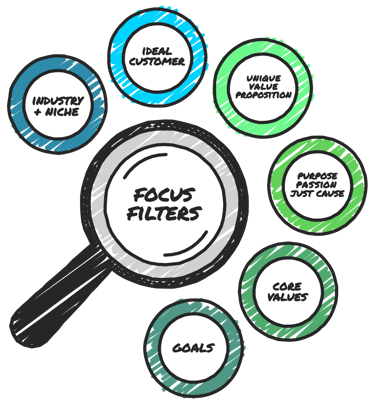Vision Statement: What It Is… and What We Teach at Ninety
A vision statement is commonly seen as a carefully constructed collection of words that, once neatly strung together, represents what a company aspires to achieve 5–10 years down the road, or even longer. At Ninety, however, we don't subscribe to the term "vision statement" because for us, the idea of a statement representing and accurately capturing such lofty expectations is just a starting point.
We believe crafting a true vision requires a comprehensive document, one that functions as a Northern Constellation that illuminates the path from our current state to the vision of a significantly more evolved organization. A vision, for us, represents a declaration of our Compelling Why, Core Values, Ideal Customer, Compelling Value Proposition, and Compelling and Audacious Goals. The most impactful vision allows everyone within our organization to collectively and individually focus, align, and thrive.
So, better than just a vision statement, we have a full-on Vision tool. This critical business tool informs our future direction, ensuring every action and decision aligns with a shared vision.
This tool also plays a crucial role in a strategic planning process that is centered on an evolving set of 3-year, 1-year, and 90-day goals (Rocks) shared with everyone in our company.
In this blog, we’ll dive more deeply into the vision by covering:- How your vision should guide your company’s strategy and culture
- The key components of a strong vision
- The difference between vision statements and mission statements
- Knowing what parts of your vision should stay constant if at all possible, and…
- Knowing what parts of your vision should evolve
Purpose of a Vision Statement
Every business has to start somewhere, but the question is, where does it aim to go as it progresses through the Stages of Development? What does the future look like? Some believe that just having a vision statement in place — or a mission statement that’s more focused on how you’ll operate right now, perhaps — is enough to start with.
But we deeply believe the act of turning a vision into reality requires passing decisions through a set of Focus Filters, the guiding principles that keep an organization aligned on what really matters. This helps shape the company’s strategy and future.
There’s a greater purpose, too. With your vision solidified, every team member essentially adopts it as their own. It transforms work from a job they’re paid to do into Work (with a capital W), something they truly love doing.
That’s when you have everyone focused, aligned, and thriving as one.
“I point our entire national community of employees to Ninety and say, this is what the vision is. This is where we're going. This is what we've committed to this year. This is where we are this quarter. This is how we're growing. And this is where we’ll be in the next three to 10 years.”
— Jennifer Zick, Authentic Brand
Key Components of a Vision
In a previous blog, we shared the Focus Filters that compose your vision:
- Determine your industry and niche
- Define your Ideal Customer
- Create your Compelling Value Proposition
- Establish your Core Values
- Decide on your Compelling Why
- Craft your Compelling and Audacious Goals
- Build out your short- and long-term goals
Essentially, these Focus Filters serve as the foundation for a company’s vision, and establishing them takes work. It also may require difficult or uncomfortable conversations, but establishing an explicit, coherent, and resonant vision will eventually lead you to forming agreements with members of your Senior Leadership Team. Once complete, you’ll find Focus Filters help clarify purpose and allow for aligned decision-making as every activity passes through the filters to ensure the right actions are appropriately taken.
The key, then, is sharing the vision beyond the Senior Leadership Team so everyone in the company understands (and agrees with) who you are, where you’re going, and what guiding principles will get you there.
Creating a Compelling Vision [Statement]
There are many notable and inspirational vision examples from well-known brands. Here are a few of our favorites to put you in the proper frame of mind for creating your own:
- Tesla: To accelerate the world’s transition to sustainable energy.
- TED: We believe passionately in the power of ideas to change attitudes, lives, and, ultimately, the world.
- Patagonia: To save our home planet.
- Cotopaxi: To eradicate poverty.
- Nike: Bring inspiration and innovation to every athlete* in the world. (*If you have a body, you are an athlete.)
The last three in particular stand out to us because they speak to everyone. As an example, whether you’re a world-class athlete with an eight-figure annual contract or a gym rat who just wants to run up and down the court at least three times a week, Nike’s vision is relatable. And it inspires.
In business, inspiration can drive serious results. A vision can help any business grow beyond its current state, no matter how small. That vision becomes especially important when deciding which way to take the company or whether to pursue certain work. The more compelling the vision, the more inspired — and invested — team members will be to help the company achieve its aspirations for the future. You’ve given them a rallying cry.
So take the time needed to really think about that future and those dreams. Get specific about it by focusing not on the “how” (which will become your goals) but the “why” that guides your efforts toward a greater purpose.
See how you can create your vision with Ninety.
Vision Statements vs. Mission Statements
When you’re ready to roll up your sleeves and do the work of crafting a vision for the future of your company, it’s more than likely someone will raise the question of whether you should also be discussing mission statements, something that guides today’s work.
We certainly understand that constructing any such statement — whether it’s mission, values, or vision — is an exercise that’s familiar to many, either anecdotally or through previous experience. As we’re fond of saying here at Ninety, though, “Less is more, until it's not.” The big idea is to have a vision that incorporates the essential ingredients found in well-constructed mission and vision statements — and more.
We’re not saying to forego a mission statement altogether. But to be clear: If you’re thinking about where you want to be in 10 years, a mission statement is not going to be helpful. Such statements deal with the here and now. It’s not grounded in your passion for that Big Idea.
You want to take what you’ve built and scale it to something that’s truly remarkable. Like crafting the vision itself, this will take time. We advocate for focusing on goals and the Rocks that will help you enable them. Bit by bit, you’ll see your future take shape.
Evolving Your Vision
Let’s face it, things change. Especially in business. Every quarter, you should update your 90-day goals and once a year your 3-year and 1-year goals. Market conditions or other external forces might compel adjustments to the kinds of KPIs you call out in your vision. At Ninety, these KPIs include the number of companies running on Ninety, the total number of paying Seats, and our client satisfaction rating.
You know you’ve nailed your vision when certain things are clearly set in stone, like your Core Values, your Compelling Why, the definition of your Ideal Customer, and your Compelling Value Proposition.
If you’re just a year or two into setting your vision and some of the non-goal-related Focus Filters need a tweak or two, don’t see these changes as a failure or shortcoming; see them for the opportunity they are. When you evolve your vision, you communicate an aligned direction to your teams. Everyone gets re-centered to then move in the same direction toward the long-term goals you’ve established.
Our Vision tool is built for easy updates that can be shared across your entire organization. Have a look.
Common Mistakes to Avoid
Perhaps the biggest thing to keep in mind when crafting your vision is this: If you know how you’re going to achieve it, then you’re thinking about goals, not a vision. The vision is your dream.
So dream big, and don’t fall into the tactical. (At least, not yet.)
Another key mistake to avoid is chasing every idea or opportunity in the interim. Here’s why that’s problematic:
• It distracts you from your true Compelling Why.
• It stretches or diverts your resources.
• It slows down the gains made from compounded efforts.
• It frustrates team members who are asked to change course.
• It hurts morale as people sense the company’s loss of direction.
Remember, the vision is your Northern Constellation. Stay the course.
Embrace Your Vision with Ninety's Vision Tool
Ninety gives you everything you need to turn your vision into reality. Download the Vision Builders Workbook today to get started. You can use our Vision tool to document every element you create while going through the workbook.








